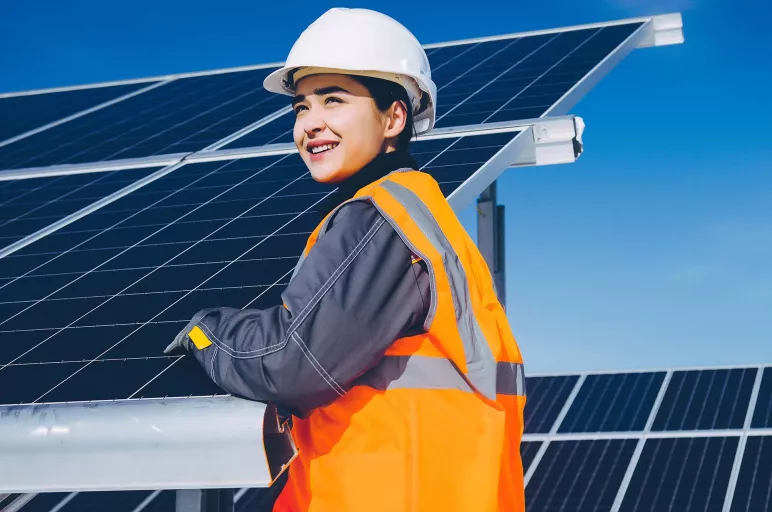
Fluctuations in the European Solar Panel Supply Chain
July 22, 2020 | Energy & Utilities
Renewable energy accounted for 18.9% of the energy consumed in the EU and is expected to hit 20% by the end of 2020. A significant share of this green energy comes from solar power. The EU is a leader in embracing solar power by adopting significant policy measures to ensure the accessibility of solar technologies to consumers. Solar energy has evolved to become one of the most cost-efficient pathways to harness energy. In the decade between 2009-2018, production costs for solar power reduced by 75% despite a growing market. The EU’s output of photovoltaic electricity reached 127 terawatt-hours in 2018, constituting 3.9% of the EU’s gross electricity output. The EU market grew by 8 gigawatts in 2018 and by around 15 to 17 GW in 2019.
China and COVID-19 Bottlenecks
The global supply base for photovoltaic products is concentrated in China. In 2019, China’s silicon wafer production capacity was 173.7 GW, 93.7% of the world’s total. Furthermore, China accounted for 77.7% of the global capacity for solar panels, 69.2% of the global photovoltaic module capacity and 69% of the world’s polycrystalline silicon capacity.
While outsourcing production to China guaranteed efficiency and economic incentives for the EU, the supply chain grew less resilient to shockwaves. Photovoltaic production in China came to a standstill at the beginning of February. Production decreased significantly due to limited transportation directly affecting the export market. Consequently, many orders are expected to be lost due to restrictions on travel. Modules for the planned projects or components for module production outside of China were also hit. This abrupt discontinuation in production from China delayed the deliveries of solar panels by close to six weeks in the first quarter of 2020.
Price increases were already evident across Europe in February. In Germany, most companies reported that they still had enough modules. However, once manufacturing operations normalized in March, capacity utilization rates were restored by more than 80%, which gradually stabilized the delivery of solar panels.
Europe and a Tilt in the Balance
Photovoltaic manufacturers in China were able to resume production in March 2020 and eagerly looked forward to clearing the lag in deliveries. However, by then, COVID-19’s effects were being felt by end users. The emphasis shifted from limited supply in February to diminutive demand in March as infections in the west marched upwards, triggering price drops. Late module delivery, coupled with an absence of installation workforce in Europe, had a double negative impact on the returns of projects. Since, this assessment is not very concrete, the belief that any potential delay will add to the cost cannot be discarded. More than 75% of industry observers expect a decline in the global photovoltaic market.
Europe's Determination Toward a Greener Future
For Europe to achieve its sustainability goals, it is imperative for the Union to jettison its dependence on unclean energy sources and simultaneously accelerate the adoption of energy sources that assure a minimal carbon footprint. So far, it has been performing well.
COVID-19 exposed a key vulnerability in the EU supply chain — resilience. After turmoil prevailed during February, and March, stability eventually returned in form of a buyer’s market. The ramifications of the pandemic are expected to invite their own share of challenges. Falling crude prices and contracting GDPs have conventionally left renewables as less desirable. During such times, governments find it less lucrative to fuel novel renewable energy projects that are inadvertently reliant on economic incentives.
With China set to remain a key link in the chain, owing to its economic incentives, a shock wave there will cause ripples to travel to the European shores. The EU market has realized the importance of resilience and sustainability in their supply chain. Ensuring energy security should be coupled with minimizing dependence on imports in sensitive fields of energy generation. The roadmap to increasing the manufacturing of solar panels in Europe will be long and challenging, demanding sustained support from all stakeholders.
References
- https://ec.europa.eu/eurostat/statistics-explained/index.php/Renewable_energy_statistics#:~:text=In%202018%2C%20renewable%20energy%20represented,EU%20reached%208.3%20%25%20in%202018.
- https://ec.europa.eu/energy/topics/renewable-energy/solar-power_en
- https://in.reuters.com/article/us-china-renewables-solar/china-to-restrict-expansion-of-solar-equipment-producers-idINKBN235128
- https://www.pv-magazine.de/2020/03/20/pv-info-link-sieht-welleneffekte-von-covid-19/
- https://www.pv-magazine.de/2020/04/17/covid-19-solar-storage-business-climate-index-77-prozent-erwarten-ruecklaeufigen-photovoltaik-weltmarkt-2020/
Turn ideas into action. Talk to GEP.
GEP helps enterprise procurement and supply chain teams at hundreds of Fortune 500 and Global 2000 companies rapidly achieve more efficient, more effective operations, with greater reach, improved performance, and increased impact. To learn more about how we can help you, contact us today.

Santosh Nair
Vice President, Technology
Santosh has over 12 years of experience managing large-scale procurement transformation engagements for leading Fortune 500 companies.
At GEP, he’s responsible for developing new products and services by incorporating complex aspects of mobile interfaces, social media, cloud computing and big data.



